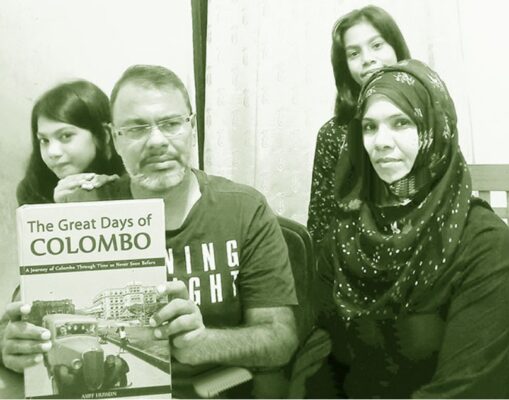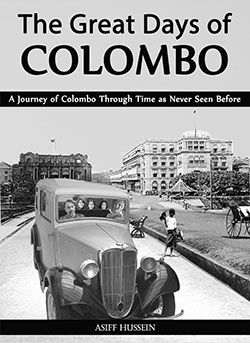Great Days of Colombo, the story of our big city-by Ifham Nizam

Source:Island
‘The Great Days of Colombo’ by Assif Hussein was released recently. This profusely illustrated and compelling work tells the story of how Colombo grew from very small beginnings as a simple Moorish port to become what it is today, a bustling city full of life and colour.
The evolution of the city is traced in much detail and its rich history vividly described with stories of war, horror and pillage that followed European colonialism and then the rapid growth of the city under Western domination.
Colombo was in a sense a meeting point of East and West and a melting pot which attracted people of many nations to come here and call it home. The story of Colombo is in short, the story of a modern nation in the making. The Great Days of Colombo brings this out vividly. Beside the city as a whole, the book focuses on each zone of Colombo dedicating a chapter to each distinct area, covering the growth and evolution of that particular neighborhood over time.
Among other things, it traces the origins of place names and street names and covers the main landmarks of each area as well as businesses and prominent residences therein. Boxed portions in each chapter bring out the most interesting facts and facets of Colombo that should interest the reader. The work is illustrated with over 800 rare, vintage monochrome and colour photographs including by renowned photographers Clarence Morang, Stephen Owens and Dominic Sansoni, sketches, paintings and artists impressions that add to the great story that is Colombo.
In this exclusive interview, author Asiff Hussein talks about his latest book.
Q: What prompted you to write ‘The Great Days of Colombo’?
A: It’s a long story really. I’m very much a Colpetty (Kollupitiya) boy. So I guess it has to do a lot with that sentiment. My childhood with a Muslim father and a Sinhalese mother whose parental homes were very close to one another has also nourished what I’ve written with fond memories of our great city.
 My parents’ auctioning business was located in Colombo, and mostly held at the Girls Friendly Society Hall. We used to go for strolls and runs on Galle Face green, swing and frolick at Victoria Park, shop at Cargills in the Fort, enjoy a movie at the Liberty, Majestic or Savoy, munch hot fish buns at the main Perera & Sons outlet or sip a refreshingly cool Faluda at Bombay Sweet House in Colpetty. Then there was the shopping experience at Cornel’s, Colombo’s first Supermarket, also at Colpetty or my uncle Nazir’s Bang Bang Complex with its escalator and little shops in the heart of Pettah. What wonderful times they were. But I guess the inspiration to write a book about Colombo came from my contributions on various places in the City to the Roar Online Magazine started by Mustafa Kassim which had a very good response and still does whenever they are shared on Facebook groups or other media. It showed how much Colombo-wallahs loved their city and were so passionate and sentimental about it. So that’s when I got started. It was done within a couple of years because the Covid crisis gave me a lot of free time to focus on the book. Even taking photographs were easier with deserted streets and buildings.
My parents’ auctioning business was located in Colombo, and mostly held at the Girls Friendly Society Hall. We used to go for strolls and runs on Galle Face green, swing and frolick at Victoria Park, shop at Cargills in the Fort, enjoy a movie at the Liberty, Majestic or Savoy, munch hot fish buns at the main Perera & Sons outlet or sip a refreshingly cool Faluda at Bombay Sweet House in Colpetty. Then there was the shopping experience at Cornel’s, Colombo’s first Supermarket, also at Colpetty or my uncle Nazir’s Bang Bang Complex with its escalator and little shops in the heart of Pettah. What wonderful times they were. But I guess the inspiration to write a book about Colombo came from my contributions on various places in the City to the Roar Online Magazine started by Mustafa Kassim which had a very good response and still does whenever they are shared on Facebook groups or other media. It showed how much Colombo-wallahs loved their city and were so passionate and sentimental about it. So that’s when I got started. It was done within a couple of years because the Covid crisis gave me a lot of free time to focus on the book. Even taking photographs were easier with deserted streets and buildings.
Q: How did you manage to find a publisher, especially at a time when the economy is in retreat?
A; My publisher, Neptune Publications headed by Dinesh Kulatunga, has always been supportive. They have not turned down even one of my books which by itself was incentive enough to keep writing and publishing books on subjects ranging from ethnology, sociology, linguistics, culinary heritage and even on mysteries and strange customs. They were enthralled by my latest work, Great Days of Colombo. It was a very large volume running to over 800 pages which probably made it the biggest coffee table book in Sri Lanka. They were worried about the printing cost. Fortunately, I already had a possible sponsor in mind – a company whose story reflected Colombo’s own. That was Expolanka. They had done well in these trying times and I wrote to their CEO, Hanif Yusoof, telling him I had a camera-ready copy of the book ready for printing.
He was enthused and the very next day I got an overseas call from him expressing his interest in publishing the book. So that was that. I guess no other author had it so easy getting a sponsor. It’s thanks to Expolanka that we got the book out in time for December 2021 just as I wanted. That was indeed a dream come true.
Q: Any ideas to share on how to write a good book?
A: Very simple. There is one word that says it all – Obsession. Call it what you will, love, passion whatever. but these don’t capture that spirit which you need to have when you’re working on a book; and I would call that Obsession for want of a better word.
So you need to be obsessed when you’re writing a book, but for that you need time, plenty of free time, God-given time which I fortunately have as a freelance writer, editor and journalist. Once you decide to write a book, you need to picture in your mind’s eye what it would turn out to be. You need to think of what you plan to cover and have an idea of where each section would fit, meaning which chapter will cover what. Also you need to plan the flow your book, for instance whether it would be subject or area-based or chronological. Then comes the hard part visiting libraries and archives to gather material which you deem relevant, followed by field visits where needed.
More painstaking, the laborious process of researching and reaching certain conclusions by comparing the information collected. Once you decide what needs to go into the book, you will need to arrange the contents properly to give it a flow. Always remember you are writing for the reader, not for yourself. So make sure only those details that would interest the reader get in. We are fortunate to have some very good resources including the National Archives and Colombo Museum Library.
The Archives has a fine collection of rare works including Dutch era land registers known as the Thombos, British era records and old newspapers while the Colombo Museum Library has a collection of books and pamphlets, some going back over a 100 years giving us an idea of what life was then like. Even not so well known school libraries tend to have rare works in their collection like the Zahira College Library whose librarian, Anoja Serasinghe, has done a great job preserving its rare collection for posterity. Some of what it holds is not found anywhere else.
Nowadays one is fortunate to have online access to the collections of overseas museums and archives like the Rijksmuseum in the Netherlands holding much material including old maps and paintings which are now in the public domain and can be freely used including in publications. In fact I was able to make good use of the Rijksmuseum collection relating to the former Dutch possession of Ceylon, some of which is probably published for the first time in my book.







